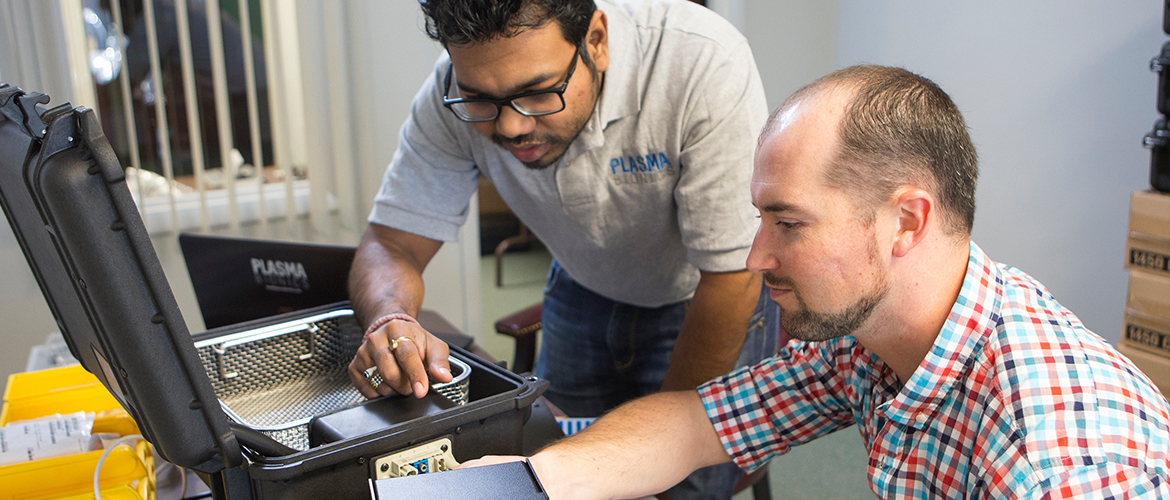
Investors reward OSU technology entrepreneurs
Monday, April 2, 2018
The odds of any technology startup succeeding are low, but it happens with a good idea, the drive of its founders and capital. What began as an Oklahoma State University engineering research project is now a growing venture with a product, eager customers and financiers who have invested more than $1.35 million in Plasma Bionics.
Started by a group of former Oklahoma State University graduate students, the team behind Plasma Bionics developed a simple, mobile device to sterilize medical instruments. Now headed by Kedar Pai and Chris Timmons, both OSU doctoral recipients and two of the company founders, the pair have worked since 2012 to develop and test the system and identify target market needs. That work has been rewarded by investors.
Infant businesses, especially technology startups, live and die based on capitol until a product is ready to market and begins to sell. Seed investments to get Plasma Bionics off the ground came from Cowboy Technologies, a part of the OSU Research Foundation, and grant funding from the Oklahoma Center for Advancement of Science and Technology.
Then the business really took off with the recent $1 million investment from a group of angel investors confident in Plasma Bionics’ potential despite the inherent risk funding high-tech ventures. That financial boost reassured Pai and Timmons that they were on the right path and that years of work would pay off.
“When people are willing to invest the dollars, that validates what we believe – that this product is viable and the company will grow and become something big,” said Pai.
The PZ100 sterilizes medical instruments using plasma, or ionized air, which kills pathogens by destroying cell membranes, DNA and proteins. It operates at room temperature and only requires electricity. Other sterilization systems require high temperatures, steam, or harsh chemicals, making them costlier to operate and limiting where they can be used. A chief benefit of the PZ100 is its portability.
Originally, the plasma research began as a project for the U.S. Air Force led by Dr. Jamey Jacob, a mechanical and aerospace engineering professor, that included Pai and other company founders. And as often happens with research, their work identified an entirely different use for plasma.
“The science started as a project where we were using plasma for flow control on aircraft wings,” said Pai. “But we actually found that our proprietary method of generating plasma could be useful for decontamination and disinfection.”
Pai and fellow students began experimenting with plasma sterilization and were introduced to Timmons, who earned a doctorate in plant pathology. His expertise in microorganisms was a valuable addition to the team.
Pai and Timmons developed the concept to the point it was time to protect it. They applied for and were granted a U.S. patent for the plasma generation technology and a unique sterilization chamber that are licensed from OSU.
The PZ100’s design is simple and can be used in hospitals or taken to patients in mobile health clinics and veterinary practices, and overseas in humanitarian settings. Veterinarians have been especially interested in that portability because it can be used in a vehicle. Timmons and Pai asked veterinarians to try the system under actual working conditions and their feedback helped fine-tune the final design. Field testing has created a buzz among vets who heard about it.
“We gave it to one of the veterinarians here in Stillwater and she tried it out for herself and liked it so much that she started introducing it to other veterinarians and became a spokesperson for us,” Pai said.
Although its initial target market is veterinarians, Plasma Bionics will apply for certification from the Food and Drug Administration to allow the system to be used to sterilize instruments for human medical and dental markets.
Daniel Will, executive director of Cowboy Technologies and a business startup mentor, said Pai and Timmons have the right mind-set to navigate the precarious world of starting a high-tech business. It takes the right kind of personality and perseverance to go from scientist and engineer with an idea to an entrepreneur with something to sell, he said.
“This is a turbulent process. It’s a long haul,” Will said. “Taking technology that you know works at the lab bench level and turning it into a commercial product that customers will buy is difficult. These guys have executed very well.”
Timmons said learning the business side of commercialization wasn’t in their training to be scientists and engineers. But working with faculty in the Student Startup Central in the Spears School of Business set them on the right path. It also netted them several thousand dollars for placing in student business plan competitions.
“That effort to understand how to convert technology into a product makes a person able to solve real-world problems, not just hypothetical ones,” Timmons said. “All of this goes along with the land-grant mission of OSU to convert research into real-world solutions.”
